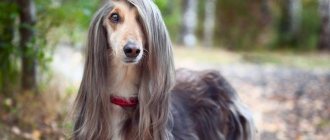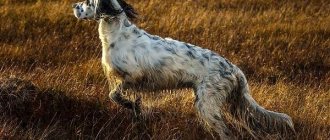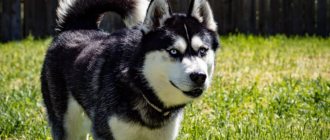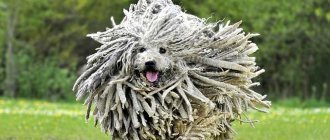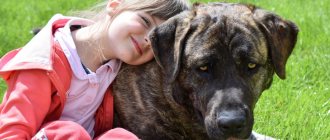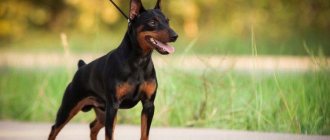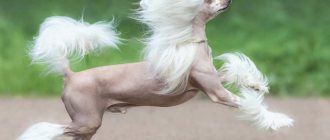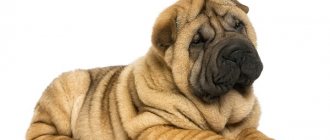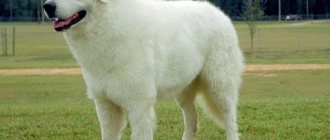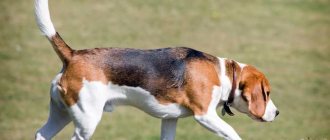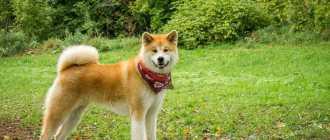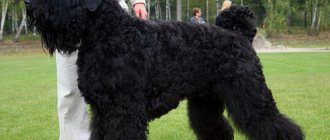Hunting breeds are a separate category. These dogs do not curry favor, they do not care about the owner’s property, and running away after an interesting smell, abandoning a person, is in the order of things.
But what is more beautiful than such a dog at work when it shuttles across a field, chases a hare, or sings loudly while chasing a fox?
It is difficult to choose such a pet: each type was bred to work on a specific animal. In addition, even breeds from the same group work at different tempos and with different techniques. A review of the 15 best hunting dogs with names and photos will help you navigate the diversity and choose the ideal “hunting dog.”
Features of dog breeds for hunting
Due to public outrage and numerous bans, even the best hunting dogs had to be reclassified as companions. Despite this, the innate passion for searching and pursuing wild animals and birds still remained in them. Such pets are instinctively aggressive towards smaller animals (cats, birds, rodents), which is very important to take into account when raising and keeping them.
According to the method and object of hunting, four-legged hunters are divided into 5 groups:
- greyhounds;
- hounds;
- burrows;
- guns;
- likes.
In this article, terriers and spaniels with retrievers are placed in separate groups. Despite this, the first are classified as burrows, and the rest are classified as guns. A group of cops, part of the gun squad, was also analyzed separately.
How skills are transferred and developed
Despite the innate instincts, the skills characteristic of hunting dog breeds are not inherited. Without timely education and regular training of a mature pet, it is impossible to achieve outstanding results.
The development of hunting skills begins at 5-7 months, when the pet already knows basic commands. The first training sessions focus on baiting and training. They begin full-fledged hunting no earlier than 8 months, focusing on the individual abilities of the animal.
Ultimately, the key to success is proper training, and not parental genes. For this reason, you should not rely on the merits of the father and mother when choosing a puppy.
Differences between a show individual and a hunting individual
The mere fact that a dog belongs to breeds bred for hunting does not guarantee its performance. Many breeders breed these four-legged animals for financial reasons. It is most profitable to sell show animals - animals with an ideal exterior, but low working qualities.
If the purpose of your purchase is to track an animal together, then look for puppies among advertisements from professional hunters, which can be found on specialized forums. For breeding, they use individuals with the most outstanding working qualities. You can also contact them for training services for your pet.
Fox terrier
The breed was bred for fox hunting, but now its scope has expanded significantly. The Fox Terrier is distinguished by its compact size, endurance and good eyesight. It can sit in a small den for a long time, waiting for prey, and then instantly chase it.
The dog is taken to hunt birds, foxes, raccoons, and badgers. The peculiarity of the breed is its good grip. Although the Fox Terrier is small in size, its fangs are not inferior to large dogs. Once a dog has caught prey, it will not let it go.
Greyhounds for hunting
Greyhounds are a group of hunting dog breeds designed to work without a gun. They have a dry and lean body, long limbs and an elongated skull, increasing the natural viewing angle. These four-legged animals work in a group and only in open, well-observed areas. Their main advantages are sharp vision, endurance and high speed.
Greyhounds' sense of smell is poorly developed, as they do not follow the scent. Having noticed prey, four-legged hunters accelerate to 70 km/h, catch it and strangle it.
Russian greyhound
Perceives all small animals as potential game. Because of this, he does not get along with cats and rodents at all. When growing up together, the Russian Greyhound is more likely to resign itself to having another pet, but does not seek to make friends with it.
Shows melancholy around the family. Outside of the work environment he practically does not speak. Walking with a tail is not typical for these four-legged animals.
Has a neutral attitude towards children. Sharp screams frighten her, but instead of aggression, the animal prefers to simply move away from the source of the noise.
Saluki (Persian greyhound)
Saluki is a hunting dog breed with a minimal amount of body fat. Thanks to her speed and strong physique, she demonstrates excellent results not only in hunting, but also in greyhound racing.
Like the Russian dog, the Saluki is silent and independent. Despite this, she loves her owner with all her heart and cannot stand prolonged loneliness.
Greyhound (English greyhound)
The fastest breed in the world has a calm temperament and gravitates towards soft mattresses. The Greyhound doesn’t mind lying on the sofa or bed at all for the whole day, if a little earlier he managed to splash out his energy in pursuit of game - or at the next running competition.
Afghan Hound
The luxurious coat of the Afghan Hound requires very careful care. Maintaining a spectacular appearance requires serious financial expenses or at least basic grooming skills.
Unlike other greyhounds, the Afghan is very difficult to train. But the relatively long memory of commands is not explained by a meager mind, but by innate stubbornness and independence.
Setters
Setters are the true aristocrats of the dog world. Setters still participate in the hunt, demonstrating incredible skill and willingness to work. All representatives of the breed (English, Irish) have a soft, friendly character; they are true companions who cannot imagine life without a family. The setter requires a lot of attention because... Without communication with the owner, animals can even become seriously ill. Setters are easy to train, get along easily with other animals, and love children very much. Another advantage of the species is the wool - soft, shiny, like silk of the highest quality.
Hound dogs for hunting
Hounds are a group of hunting dog breeds intended for driving. They are distinguished by a ringing voice with a characteristic yodel. The tasks of the four-legged animal include bringing the animal under the gun or a pack of greyhounds. It is also allowed to drive into a hole, where the baton of catching is taken over by the burrow dogs.
Unlike greyhounds, hounds follow the scent, that is, they rely on scent. During pursuit, they move quite far from the owner, so they report the sight and position of the target with various vocal modulations. They are used to catch roe deer, wolves and wild boars.
Estonian hound
He demonstrates his ruthlessness only in his work. When surrounded by family, he becomes soft and friendly, showing unusual tolerance towards children's pranks.
Thanks to its developed hunting instinct, it begins full-time work at 6-8 months. During the hunt, she becomes passionate and persistent. Can follow the trail for more than 3 days in a row.
Basset Hound
Because of its short stature, the very sad-eyed Basset Hound looks more like a burrow variety than a typical hound. Despite this, he still has a sonorous, deep voice.
Clean people should immediately abandon the Basset Hound because of the jowls. Getting rid of drool and constantly splashed water next to a drinking bowl is simply unrealistic.
Beagle
Beagles love communication and movement. The best reward for these four-legged animals is a walk in a crowded place. Only a free run somewhere outside the city can improve the impressions of this event.
Because of their curiosity, beagles often get lost. Sensing an unusual smell, they quickly lose their heads, ceasing to respond to the owner’s commands.
Russian hound
The most popular hound in Russia is still not recognized by the FCI. Has high intelligence. Quickly remembers new commands and does not need numerous repetitions. She is prone to dominance, so only an experienced dog breeder should train her.
Ear care tips
Dogs' long, floppy ears require special care. It includes:
- regular (once every 3-5 days) examination of the auditory canals;
- weekly cleaning of the ears with baby wipes (with calendula or chamomile oil) and cotton swabs, previously soaked in warm boiled water;
- course instillation of special drops into the ears;
- preventing water from entering sinks.
Dogs of the listed breeds are predisposed to inflammatory diseases and ear infections. Infection occurs due to the entry of a fungus or virus into the ear canal. The disease can also be caused by ticks or foreign bodies.
Expert opinion
Anna Abramenko
An avid dog lover. Experience in veterinary medicine since 2009.
Ask a Question
The infection is accompanied by itching, a repulsive odor and discharge. This is a reason to contact a veterinarian.
There are many dog breeds with floppy or erect large ears. But the choice of a certain type of variety depends on the preference and preparedness of the owner himself.
Pointing dogs for hunting
Pointers are a group of hunting dog breeds bred to hunt game birds. They work both in open fields and in dense thickets. They track the target using their upper senses. They follow the trail with a stealthy gait, trying not to frighten the bird before making a shot. Having reached their destination, they freeze in one of two stances:
- lift one of the front paws and stretch it forward along with the entire body;
- sit down as close to the ground as possible in the direction of the target.
When the hunter approaches, the dog scares the bird, forcing it to fly, and after shooting it down, it brings it to its owner. Suitable for hunting in swamps and other bodies of water.
Irish Setter
This ultra-sociable and affectionate dog cannot stand being alone. For a comfortable life, the constant presence of the owner is important to him, as well as frequent walks and active games. The excessive intrusiveness of the setter is a given that must be accepted. If close contact with a pet and an active lifestyle are alien to you, choose someone else.
Drathaar
This hunting dog breed has outstanding memory abilities. She quickly masters new commands and does not need long-term skill development.
The drathaar prefers any forays into nature with the aim of catching some kind of game to lying on the sofa. If you are not eager to hunt, give your pet to a group of children. The dog will be happy to join in their catch-up games and other active games.
Weimaraner
Weimaraners are notable for their aristocratic appearance and good disposition. Aggression towards strangers on their part is possible only with outright provocation.
Due to its large dimensions, the Weimaraner is not suitable for families with small children. A dog that gets too playful can injure a child, so the play company should be trusted to school-age children.
Pointer
Recognizes the authority of all family members and willingly follows commands from children. The only condition for a Pointer to be obedient is attention from a person. Thanks to regular communication, joint games and walks, you can quickly win his friendship.
Pointer puppies learn fetch early, but as they grow older they lose interest in it. Because of this, a very small number of pets retain a useful skill.
Dachshund
Nowadays the dachshund is used as a decorative dog. But the breed was bred to hunt foxes in holes. The dog can also be used to catch badgers, raccoons, and small waterfowl.
The dachshund is distinguished by its mobility and activity. The breed has a ringing voice. It is unpretentious to living conditions and tolerates cold and dirt well.
Burrowing hunting dogs
Burrowing dog breeds are characterized by willfulness, stubbornness and fearlessness. The need for these qualities is explained by the method of hunting. Chasing badgers, foxes, raccoons and other animals living in the hole, these four-legged animals act as follows:
- they smoke their victim out of the hole;
- driven into a dead end, waiting for human help;
- They independently engage in combat with the enemy inside the hole.
This group includes dachshunds and various types of terriers. In addition to the qualities listed above, they are united by a high pain threshold, which allows them to fight with a cornered animal even after receiving serious injuries.
Dachshund
This small hunting dog is ideal for keeping at home. In addition to digging holes, she loves to eat, which often affects her weight. A large deviation from the norm or frequent jumping can lead to problems with the paws, so special attention must be paid to the diet and safety of this short-legged animal.
The dachshund's occasional stubbornness is due to its independence. Don't write it off as harmful. Most likely, the pet is simply confident that the decision he made is much better than yours.
Fox terrier
Like all terriers, the Fox Terrier is an excellent example of a perpetual motion machine. Such a playful dog is not suitable for homebodies and introverts. He constantly demands attention, filling the house with his loud barking in moments of loneliness. To avoid conflicts with neighbors, it is better to immediately secure your apartment with powerful sound insulation.
German Jagdterrier
These four-legged animals die more often than others while chasing prey. The cause of their death is injuries received during the fight and the collapse of tunnels. These misfortunes occur due to a high pain threshold and too active behavior when meeting a cornered animal.
Jagdterriers choose only one owner as a pet. The rest of the family is listened to occasionally, preferring to ignore their commands most of the time.
Saint Bernard
Saint Bernards are giants with a big heart, whose ancestors are ancient mastiffs. The breed was bred in the 17th century in the Swiss Alps by the monks of the monastery of St. Bernard. St. Bernards were originally used as pack animals and rescue dogs. Thanks to their amazing sense of smell, these dogs helped find people caught in an avalanche. In addition, St. Bernards anticipated the onset of an avalanche and warned the person. The character of the dog is more like a bear, kind, patient and affectionate, there is absolutely no aggression towards humans. Saint Bernards are easy to train and are excellent patient nannies even for small children. They do not get along well with small dogs, but if they grow up together from puppyhood, then there is no aggressive behavior. (see full description of the St. Bernard breed)
Gun types of hunting dogs
The gun group includes 3 types: pointers, retrievers and spaniels. All these four-legged animals are suitable for hunting upland, waterfowl, meadow and swamp game birds, hares and other small animals. They differ from each other in the way they work:
- taking a stance is typical for cops;
- bringing shot game - for retrievers;
- lifting a bird onto the wing, that is, flushing it away - for spaniels.
Above, these skills were indicated in the job description of cops. Such behavior is indeed acceptable, but only with special training. But the skill characteristic of the breed is present at an instinctive level.
This section will discuss 2 breeds of hunting dogs that work on water.
Portuguese merman
It was bred to drive fish into nets. Differs in developed intelligence and obedience. Even a child can train this four-legged animal. For the sake of praise, he constantly tries to please his owner, regardless of his age.
Spanish merman
Recognized as the ancestor of retrievers and spaniels. Strongly attached to children. Can be used as a nanny.
In Spain, these four-legged animals are used in rescue operations. They work well on water and are capable of diving to depths of over 4 m.
English pointer
The Pointer combines the characteristics of hounds, greyhounds and hunting dogs. The breed is distinguished by its strength, high energy, persistence and endurance, making it ideal for hunting.
The pointer can dive and is able to pursue prey for a long time, so it is used when hunting birds and hares. He is also characterized by good eyesight, search skills, attentiveness, and a keen sense of smell.
When the dog notices prey, he freezes, and his body stretches out, pointing at the victim. The dog has an instant reaction, friendliness, and loyalty. The Pointer loves being surrounded by people and does not show aggression.
Read The best herding dogs - 20 breeds and their uses
Likes
Laikas are universal hunting dogs belonging to the Spitz-type breed. They are distinguished by a wedge-shaped head, pointed ears, thick undercoat and a tail curved into a ring. They hunt birds, fur-bearing animals, and even such large animals as moose and bears. Despite the versatility, it is still better to accustom your pet only to a certain type of game. This increases hunting efficiency.
The advantages of huskies include good health, the absence of breed diseases, acute vision, sensitive hearing and a developed sense of smell. They are also distinguished by their wolf-like metabolism. The stomach of huskies is not picky and easily digests any food, and during prolonged tracking of an animal, these four-legged animals suppress the feeling of hunger for quite a long time.
The name of the breed comes from the hunting method. Having discovered the animal, the dog distracts it with its barking and detains it until the hunter appears with a gun. The sonorous voice is used for this purpose only. During the pursuit stage, the husky moves as silently as possible.
Russian-European Laika
Provided it hunts regularly, it gets along well with livestock and poultry. Only puppies that practice their skills on all the animals they meet can cause trouble.
They are famous for their patience and acute reaction to undeserved punishments. You can easily snatch a bowl of food from under their noses, practicing another trick, but resentment will certainly follow an unsubstantiated accusation.
East Siberian Laika
This hunter dog has the makings of a sled dog. Despite a friendly attitude towards all family members, he recognizes the authority of only one owner.
Up to 2.5-3 years of age, it remains at the developmental level of a puppy, which is very important to consider when raising. Any pressure causes them strong resentment, which prevents them from learning skills.
West Siberian Laika
Very sociable and dependent on human communication. Interest in the owner disappears only during the hunt, giving way to serious excitement. On walks he tries to express himself independently, every now and then trying to run away about his business.
It easily tolerates severe Siberian frosts and can live in an enclosure. When purchasing this breed, it is important to understand that it is absolutely not suitable as a sofa pet.
Karelo-Finnish Laika
A cunning and independent breed. Constantly looking for loopholes to evade boring activities. Recognizes only game form of learning.
He raises his voice with or without reason, which constantly causes dissatisfaction with his closest neighbors. Doesn't trust strangers and is quite good at being a guard.
Hungarian Vizsla
The breed is characterized by intelligence and intelligence. The Hungarian Vizsla is easy to train and quickly learns new commands. The dog has a good sense of smell, loyalty, obedience, and friendliness.
The breed is used for hunting all types of game. But it is best to use the Hungarian Vizsla to catch waterfowl. The dog is an excellent swimmer and copes well with tasks on rough terrain.
Spaniels and retrievers
Spaniels and retrievers are hunting dogs that specialize in finding and retrieving shot game. They have a good upper and lower sense of smell, as well as a very gentle character. Due to their extraordinary devotion to humans and docile nature, both are quite often acquired as companions.
Russian hunting spaniel
Loves to swim in open water and can withstand cold water. When surrounded by family, he tries to slow down, splashing out all his energy during working hours.
Retains puppy playfulness until old age and gets along well with children. Forgives little owners not only strong hugs, but also periodic tugging of the ears and tail.
English cocker spaniel
Thanks to their developed sense of smell, the English Cocker Spaniel breed is attracted to the search for narcotic drugs. The four-legged animals, not on duty and deprived of the opportunity to demonstrate their skills, entertain themselves by excavating flower beds, children's sandboxes and flower pots.
Without regular exercise in the fresh air, they become fat, lazy and hysterical. Playing with a ball and Frisbee, as well as free walking in the nearby forest park, help release energy.
Labrador Retriever
This hunting dog ranks 7th among the smartest four-legged animals. Thanks to its developed intelligence and good nature, the breed is used in various rescue operations and canistherapy.
Unlike terriers, Labradors are loyal not only to people, but also to other animals. The lack of aggression is explained by the fact that he has never been involved in driving and chasing game.
Golden Retriever
The Golden Retriever, like the Labrador, is in the TOP 10 of the smartest four-legged animals, but takes a more honorable 4th place. Most often, four-legged dogs are purchased by families with children.
Instead of aggression and mistrust, goldens are characterized by a burning curiosity. When a burglar breaks in, they will simply follow him, trying to get to know each other better.
A little history
Knowledge about the types of hunting dogs was first recorded in the manuscripts of the ancient Romans. They respected their enormous patience, sense of smell and flair, admired their unexpected lightning-fast throws and victories over the game after tracking it down.
But the Romans created animals to suit their needs, the goal of Rome was to use protective qualities. The population of neighboring European countries, on the contrary, specially bred dogs, using animal hunting as their basis. Thus, ancient scientists and breeders, observing for a long time the processes of maturation from puppies to mature individuals, selected predatory catchers, drawing up their current classification and division. European dogs showed fine intelligence, speed, and mobility.
Terriers
Terriers are a type of burrowing dog breed. In addition to hunting, they are used for service and as companions. Within the city limits the following representatives are most often found.
Jack Russell Terrier
It becomes strongly attached to its owner and cannot stand being alone. A measured lifestyle is alien to him. Without regular runs and games, this dog will destroy everything that is lying around without asking, and will give your neighbors a real test of strength with its ringing bark.
Like other hunting dogs, it does not get along with rodents, cats and other small animals. Friendship is only possible when we grow up together.
Scottish Terrier (Scottish Terrier)
This shaggy handsome guy is often acquired by pensioners. Thanks to its compact dimensions, the Scottish Terrier feels great even in small apartments.
Due to their innate curiosity, any walk with these four-legged animals turns into a real adventure. The Scottish Terrier will never return home until it has searched all the holes and potholes found.
Do you like the article? 0
Poodle
The dog of French origin is famous for its intelligence and high intelligence. Puppies up to a year old show amazing tricks that even adult service breeds cannot perform. Poodles often perform in circuses due to their mental abilities and love of work. The poodle is not necessarily a decorative companion. This subspecies is divided into 4 types - large (up to 60 cm at the withers), small, dwarf and toy poodle (slightly more than 20 cm at the withers). The breed has a calm character, these animals love children and get along easily with other animals. Poodles' incredible coat requires little maintenance. With the exception of show dogs, dogs participating in exhibitions must be trimmed according to the appropriate grooming standards for the breed. Without a haircut, a poodle is not allowed to show, but the dog can participate in breeding.
